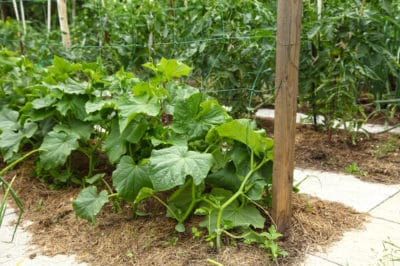Cucumbers and Sweet Corn
Pairing cucumbers with sweet corn may be the classic example of effective companion planting. Cucumbers’ scent, sometimes prickly fruit and view-concealing leaves steer hungry raccoons away from the corn. To return the favor, the cornstalks become space-saving cuke trellises. For a successful outcome:
- Plant your corn two weeks ahead of the cucumbers.
- Till a 2-inch layer of organic compost into the soil before planting the corn.
- Till a 2-inch layer of organic compost into the soil before planting the corn.
- Plant your cucumber seeds along the eastern side of the corn, in 4-inch mounds spaced 1 foot from the corn and each other. Tamp the tops of the mounds flat to limit water erosion.
- Keep the soil evenly moist (not wet) throughout the growing season.
- After the cukes vines reach 6 inches, thin them to one per corn stalk. When they’re long enough, gently wind them around the stalks so they can begin to climb.
Cucumbers and Radishes
As carriers of lethal bacterial wilt disease cucumber beetles can decimate your cuke crop. Planting two or three white-fleshed icicle radishes around each cuke may repel them. Leave the radishes in the ground even after they go to seed; they’ll also beleived to protect protect melons and squash.
Cucumbers, Nasturtiums and African Marigolds
Companion planting sometimes requires sacrificing some plants to save others. A cheerful border of annual nasturtiums and African marigolds may lure sap-sucking aphids — carriers of cucumber mosaic virus — away from cukes. Just plant both annuals with your cuke seeds and dispose of their aphid-infested leaves and stems as needed.
Cucumbers and Sunflowers
Sunflowers intermingled with your cucumbers may also protect them against aphids. Unlike smaller nasturtiums and marigolds, however, sunflowers shrug off the bugs’ feeding damage. As an bonus, mature sunflower seeds attract all kinds of native wildlife to the garden.
Expert gardener’s tips:
Beans and peas planted where they can climb the sunflowers’ stalks will enrich the soil with nitrogen. Cukes depend on a season-long nitrogen supply to fuel their rapid growth.
Squash planted at the feet of climbing cukes makes an effective weed barrier. It also discourages nails, slugs and raccoons with its prickly stems.
